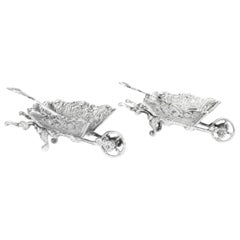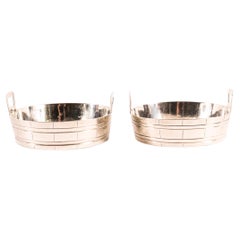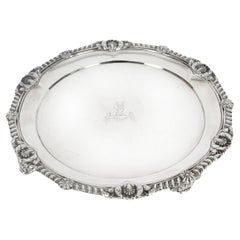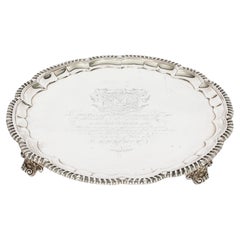Video Loading
Want more images or videos?
Request additional images or videos from the seller
1 of 21
Antique Pair of German 800 Silver Pheasants, 19th Century
$2,419.83List Priceper set
About the Item
About the Seller
5.0
Platinum Seller
Premium sellers with a 4.7+ rating and 24-hour response times
Established in 1983
1stDibs seller since 2012
1,394 sales on 1stDibs
Associations
LAPADA - The Association of Arts & Antiques Dealers
Authenticity Guarantee
In the unlikely event there’s an issue with an item’s authenticity, contact us within 1 year for a full refund. DetailsMoney-Back Guarantee
If your item is not as described, is damaged in transit, or does not arrive, contact us within 7 days for a full refund. Details24-Hour Cancellation
You have a 24-hour grace period in which to reconsider your purchase, with no questions asked.Vetted Professional Sellers
Our world-class sellers must adhere to strict standards for service and quality, maintaining the integrity of our listings.Price-Match Guarantee
If you find that a seller listed the same item for a lower price elsewhere, we’ll match it.Trusted Global Delivery
Our best-in-class carrier network provides specialized shipping options worldwide, including custom delivery.You May Also Like
An Antique Silver 800 Napkin Holder, 19th Century
Located in ARMADALE, VIC
An Antique Silver 800 Napkin Holder, 19th Century
Offers elegant design and craftsmanship. Home decor, Interior design and collectibles.
Provenance: Private Australian Collection.
...
Category
Antique 19th Century English Sterling Silver
Materials
Silver
An Antique Silver 800 Napkin Holder, 19th Century
Located in ARMADALE, VIC
An Antique Silver 800 Napkin Holder, 19th Century
Offers elegant design and craftsmanship. Home decor, Interior design and collectibles.
Provenance: Private Australian Collection.
...
Category
Antique 19th Century English Sterling Silver
Materials
Silver
Pair of Continental Silver Pheasants from 19th or Early 20th Century
Located in New York, NY
Pair of continental silver pheasants, depicted in a very realistic manner, from the 19th or early 20th century. One measures 17'' in length by 6'' in height. The other one measures 1...
Category
Antique 19th Century European Sterling Silver
Materials
Silver
Pair of Antique Silver Grape Shears, Krusius Brothers, Germany Late 19th Century
Located in Milan, IT
Pair of antique grape shears, Krusius Brothers, made of sterling silver with the motif of grapes, grape leaf, vine in three dimensions with fox heads. These shears are made in German...
Category
Antique Late 19th Century German Sterling Silver
Materials
Sterling Silver
$778
H 7 in W 3.75 in D 0.5 in
Pair of 20th Century Silver Pheasants
Located in Los Angeles, CA
Pair of 800 silver pheasants. Gold vermeil. European (probably Austria).
Category
Early 20th Century Austrian Sterling Silver
Materials
Silver
Silver 800 Cutlery Set for 12 People, Düsseldorf, Germany, Late 19th Century
Located in Buenos Aires, Buenos Aires
Silver 800 cutlery set for 12 people. Düsseldorf, Germany, late 19th century.
Jugendstil period.
Complete for 12 people.
A total of 164 pieces:
12 ...
Category
Antique Late 19th Century German Jugendstil Sterling Silver
Materials
Sterling Silver
$20,000 Sale Price / set
20% Off
H 13 in W 21.26 in D 17.72 in
Antique 19th Century Dutch 800 Silver Baroque Figural Tankard Stein 835g
Located in Dayton, OH
Rare antique 19th century Dutch lidded and footed 800 silver tankard/stein / pitcher, with ornate designs, faces and finial; gilded interior. Marked on base “JW 800M.”
Provenance: J...
Category
Antique 19th Century Dutch Colonial Sterling Silver
Materials
Silver
$3,760 Sale Price
20% Off
H 11.75 in W 5.75 in D 4.75 in
Pair Antique Silver Pheasants Model Birds Figurines Germany c. 1900
Located in London, GB
A pair of Antique Solid Silver Pheasants made in a classic style with a lovely attention to detail. The pair consists of a Cock Pheasant and a Hen Pheasant, each unique and modelled in individual poses.
Made in Germany in c. 1900.
Total Weight - 1694g / 54.47oz
Approx. Length Cock Pheasant - 35.8cm
Approx. Height Cock Pheasant - 18.1cm
Approx. Length Hen - 36cm
Approx. Height Hen - 16.6cm
This Pair of Silver Pheasants...
Category
Early 20th Century European Sterling Silver
Materials
Silver
$8,227
Free Shipping
H 0.4 in W 0.4 in D 0.4 in
A Silver Kiddush Goblet, Germany 19th Century
Located in New York, NY
A Lovely Silver Kiddush Goblet made in Germany in the 19th Century
Kiddush Goblets such as these were fairly common in many households in Germany during the 19th century.
Kiddush G...
Category
Antique 19th Century German Sterling Silver
Materials
Silver
A 19th Century Silver German Etrog Container
Located in New York, NY
This Artistic Silver Etrog Container standing on a pedestal was made in Germany in the 19th Century.
Etrog container's upper main body is shaped in the form of a realistic Etrog with undulating ridges, small circular scrolling patterns, and a stem sprouting from one side.
The beautiful raised leaf-designed base is mounted and has a wooden branch...
Category
Antique 19th Century German Sterling Silver
Materials
Silver
More From This Seller
View AllAntique Pair of French Silver Salts as Garden Wheelbarrows, 19th Century
Located in London, GB
This is a charming pair of antique French silver novelty table salt condiments in the form of garden wheelbarrows, dating from the late 19th century.
Each wheel barrow having 'C' scroll Rococo style decoration to the bodies with shaped handles and a functioning wheel.
Both table salts having a silver shovel...
Category
Antique 1890s French Sterling Silver
Materials
Silver
Antique Pair Victorian Sterling Silver Butter Dishes Dated 19th Century
Located in London, GB
This is a very attractive pair of antique Victorian sterling silver dishes / coasters with hallmarks for London 1890.
They feature attractive faux-coopered decoration with a handle...
Category
Antique Late 19th Century English Victorian Sterling Silver
Materials
Sterling Silver
Antique George III Sterling Silver Salver by Paul Storr 19th Century
By Paul Storr
Located in London, GB
This is a wonderful English antique George III sterling silver 10 inch salver, by the world famous silversmith Paul Storr.
It has clear hallmarks for London 1811 and the makers mark of Paul Storr.
It is typical of his work with the raised gadrooned rim with anthemion at intervals, on four fabulous foliate bracket feet. The salver is engraved with a crest and motto and the underside is later engraved
Charlotte J. Parke from C. J. Parke, March 1893'
The centre is engraved with a crest above a motto 'True and Fast' and I have researched this crest:
The Crest of Parke
The crest as engraved upon this George III English Sterling Silver Footed Salver by Paul Storr hallmarked London 1811 is that of the family of Parke. It may be blazoned as follows:
Crest: A stag’s head couped sable holding in the mouth a key or
Motto: True and fast
The family of Parke originally hailed from the County of Cumberland in the northeast of England1 later settling in the County of Dorset at Henbury House, Sturminster Marshal, near Wimborne. Given the evidence of the inscription found on the underside of the salver ‘Charlotte J. Parke from C. J. Parke, March 1893’ it was undoubtedly at one time in the possession of Charles Joseph Parke (died 9th March 1893) of Henbury House aforesaid and gifted to Charlotte Josephine Parke (baptised 4th January 1857 died 2nd January 1941) his third daughter by his wife, Ellen Mary Ethelston. I would venture the following hypothesis that the salver was bequeathed to Charlotte in her father’s will that was granted probate at London on the 20th May 1893. The ‘March 1893’ of the inscription acts as a remembrance of the month of the death of her father. It was noted that Charlotte’s father left an estate worth some £66,892, 19 shillings and one pence, a very considerable sum in the last decade of the 19th Century and even thereafter. Charlotte never married and was living at the time of her death at The Coppice, Sixpenny Handley in the County of Dorset. Her will was proved for probate at Llandudno on the 25th March 1941. She left an estate worth £18,866, 10 shillings and 4 pence. Again, a comfortable sum in 1941.
See the photo of Henbury House, Sturminster Marshal, near Wimborne, Co. Dorset. The former seat of the Parke family. The house was destroyed by fire, the remains of which were demolished in the 1990's.
There is no mistaking its unique quality and design, which is sure to make it a treasured piece by any discerning collector.
Condition:
In excellent condition with clear hallmarks and no dings, dents or signs of repair. Please see photos for confirmation.
Dimensions in cm:
Height 2 x Width 26.5 x Depth 26.5
Weight 0.69 kg
Dimensions in inches:
Height 1 inch x Width 10 inches x Depth 10 inches
Weight 1.5 lbs
Paul Storr
born in London England in 1771, was to become one of the most talented silversmiths of the nineteenth century. Today his legacy of exceptionally well crafted silver, found worldwide in museums and private collections, leaves one in awe when compared to that of his contemporaries.After having served a seven year apprenticeship from the age of 14, he began his career in 1792 when he went into a brief partnership with William Frisbee. This did not last and in 1793 a new mark, (his initials ‘P S’) was entered. By the beginning of the nineteenth century he had established himself as one of London’s top silversmiths producing, amongst others, commissions for Royalty.
In 1801 he married Elizabeth Susanna Beyer with whom he was to have ten children. In 1807 Paul Storr entered into a working relationship with Philip Rundell and by 1811 was a partner, and managing the workshops for Rundell, Bridge & Rundell.
During this period he kept his own marks and separate workshop. However it was through Rundell, Bridge & Rundell who were appointed Goldsmith in Ordinary to George III in 1804 that his reputation as a master silversmith grew. His talents lay in being able to transform ideas and designs from Rundell, Bridge & Rundell’s designers, William Theed...
Category
Antique 1810s English George III Sterling Silver
Materials
Sterling Silver
Antique Large William IV Silver Tray Salver by Paul Storr 19th Century
By Paul Storr
Located in London, GB
This is a wonderful English antique William IV sterling silver tray, or salver, by the world famous silversmith Paul Storr.
It has clear hallmarks for London 1820 the makers mark of Paul Storr.
It is typical of his work with the octafoil shape and the exquisitely detailed reeded rim, and it is raised on four delightful foliate and scroll feet.
The centre is engraved with a shield shaped coat of arms which I have had researched.
The Marital Arms of Knollis and Hallifax
The armorial bearings as engraved upon this George IV Large English Sterling Silver Footed Salver by Paul Storr hallmarked London 1820 are those of the family of Knollis with Hallifax in pretence. These armorial bearings denote the marshalling of a marital coat showing the arms of the husband over the entire surface of the shield, whilst the arms of the wife (as an heraldic heiress) are placed on a small shield (known as an escutcheon of pretence) centrally on the husband’s arms.
They may be blazoned as follows:
Arms:
Quarterly 1st and 4th Azure crusily of cross crosslets a cross moline voided or (for Knollys) 2nd and 3rd Gules on a chevron argent three roses of the field barbed proper (for Knollys) over all an escutcheon of pretence Or on a pile engrailed sable between two fountains barry wavy of six argent and azure three cross crosslets of the first (for Hallifax)
Crest:
An elephant argent [differenced with a mullet1 ] (for Knollys)
Motto:
In utrumque paratus [Prepared for either] (for Knollys)
These armorial bearings undoubtedly commemorate the marriage of The Honourable and Reverend Francis Knollis2 (baptised 3rd January 1743 died 27th February 1826),
1 The cadency mark for a third son of a family. 2 Francis appears to have preferred this spelling of his family’s surname. It is spelt as it is to be pronounced.
of Burford in the County of Oxfordshire and of Eastleach Martin in the County of Gloucestershire and Mary Hallifax (baptised 5th March 1753 buried 18th December 1830). Francis and Mary were married at the Parish Church of St Mary, Ewell in the County of Surrey on the 9th June 1772. Francis was the third son of Charles Knollys (the titular 5th Earl of Banbury) 3 and his wife, Martha Hughes, whilst Mary was the daughter of The Reverend James Hallifax, of Ewell aforesaid and his wife, Elizabeth Chardavoyn.
3 Francis’s father claimed to be the 5th Earl of Banbury. A claim that continued to be pursued by the family until William Knollys, the titular 8th Earl of Banbury (born 1763 died 1834) was forced to discontinue its use by a resolution of the House of Lords which rejected his claim to the earldom in 1813.
The crest surmounts a detailed dedication:
This piece of plate was presented to the Honourable Rev Knolls by the inhabitants of the town and immediate neighbourhood of Burford on his completing the fiftieth year of his incumbency as the vicar of Burford.
In testimony of their high respect 11th April 1821
There is no mistaking its unique quality and design, which is sure to make it a treasured piece by any discerning collector.
Condition:
In excellent condition with clear hallmarks and no dings, dents or signs of repair. Please see photos for confirmation.
Dimensions in cm:
Height 3 x Width 36 x Depth 36
Weight 1.52 kg
Dimensions in inches:
Height 1 inch x Width 1 foot, 2 inches x Depth 1 foot, 2 inches
Weight 49 troy oz
Paul Storr
born in London England in 1771, was to become one of the most talented silversmiths of the nineteenth century. Today his legacy of exceptionally well crafted silver, found worldwide in museums and private collections, leaves one in awe when compared to that of his contemporaries.After having served a seven year apprenticeship from the age of 14, he began his career in 1792 when he went into a brief partnership with William Frisbee. This did not last and in 1793 a new mark, (his initials ‘P S’) was entered. By the beginning of the nineteenth century he had established himself as one of London’s top silversmiths producing, amongst others, commissions for Royalty.
In 1801 he married Elizabeth Susanna Beyer with whom he was to have ten children. In 1807 Paul Storr entered into a working relationship with Philip Rundell and by 1811 was a partner, and managing the workshops for Rundell, Bridge & Rundell.
During this period he kept his own marks and separate workshop. However it was through Rundell, Bridge & Rundell who were appointed Goldsmith in Ordinary to George III in 1804 that his reputation as a master silversmith grew. His talents lay in being able to transform ideas and designs from Rundell, Bridge & Rundell’s designers, William Theed...
Category
Antique 1820s English William IV Sterling Silver
Materials
Sterling Silver
AntiqueFrench Silver Miniature Sedan Chair 19th Century
Located in London, GB
This is a charming antique French 800 silver miniature sedan chair, Circa 1870 in date.
The sedan chair beautifully detailed, the door opens to ...
Category
Antique 1870s French Sterling Silver
Materials
Sterling Silver
Silver George III Tureen William Bennett 1808 Birchall and Hayne 19th Century
By William Bennett
Located in London, GB
This is a beautiful antique English George III sterling silver tureen and lid, with hallmarks for London 1808 and the makers mark WB for William Bennett.
The tureen is beautiful i...
Category
Antique Early 1800s English George III Sterling Silver
Materials
Sterling Silver
Recently Viewed
View AllMore Ways To Browse
800 German Sterling Silver
Pair Of Silver Pheasants
Sterling Silver Pheasants
Silver German Pheasants
Acanthus Sterling Silver Serving Pieces
Antique Hair Brush
Clothes Brush
Imperial Russian Glass
Large Silver Serving Spoon
Sterling And Glass Match Striker
Sterling Silver Salver Tray
Sterling Silver Sugar Caster
Sterling Silver Tray English
Sterling Swan
Victorian Cutlery
Victorian Sterling Silver Goblet
Vintage M Monogram
Antique English Sterling Silver Hallmarks



